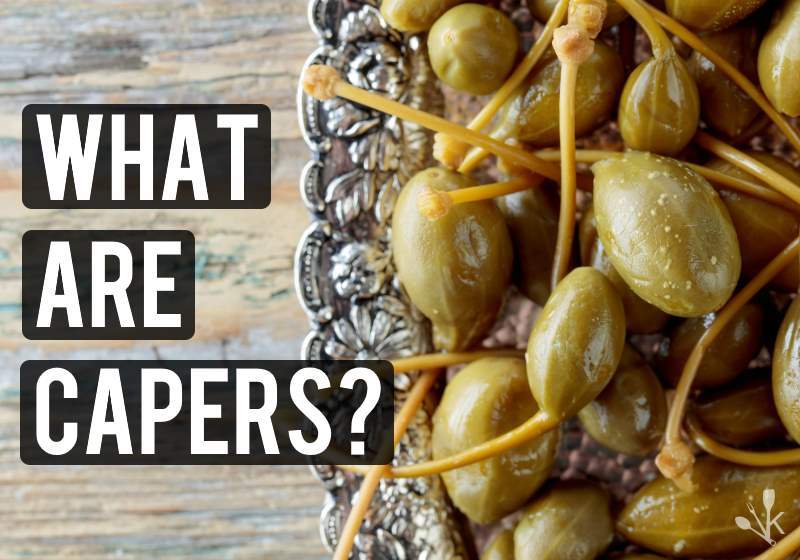What are capers? If you’ve ever had a smoked salmon bagel or gotten a salad nicoise, you’ll probably find little green buds scattered across your plate.
Capers are pickled or brined flower buds. They offer a burst of earthy flavor in every bite. If you like olives, you’ll probably like capers. If you don’t like olives, try them anyway.

While some people can find olives rather bitter, capers don’t have a harsh finish. They are generally quite tart, and the smallest can be quite chewy.
What Do Capers Taste Like?
| Flavor | Capers Taste |
|---|---|
| Sweet | Capers have a sweetness rating of 0 out of 10. This pickled flower bud is cured in vinegar or brine, so don’t use it over dessert. The natural flavor is earthy, not sweet, as they’re picked in the bud stage and not allowed to ripen. |
| Sour | Capers rate 9 out of 10 for sour flavor. If you need a lemon substitute for a sauce or garnish, capers will work, particularly those pickled in a vinegar solution. |
| Salty | Capers rate 8 out of 10 for saltiness; if you like olives, you’ll enjoy capers. If sodium is a concern, look for pickled (as opposed to brined) capers. |
| Bitter | Surprisingly, capers are only 3 out of 10 for bitterness. Yes, they are earthy, but not sharply so. For those who don’t tolerate brined foods well, make sure to rinse your capers before you add them as a garnish. |
What Are Capers Made Of?
Capers are flower buds, harvested from the Capparis Spinosa. This plant is sometimes called the Flinders rose.

Where do capers come from? The Capparis Spinosa can grow in salt water and survive the extremely dry conditions found in the Mediterranean.
If sustainable eating is important to you, any food harvested from a plant that doesn’t require fresh water should be high on your list!
What are non pareil capers? They are the smallest fruits in a ranking of six. If you find the price of capers off-putting, remember that these delicate buds can only be harvested by hand.
They’re sorted and sold by six different sizes. The smallest are non-pareils at less than 7 millimeters in diameter, while the biggest capers, grusas or caper berries, are up to 14 millimeters.
When comparing caper berries vs capers, remember that the littlest ones are the most expensive so save them for garnishes and finishes.
Are capers a vegetable? While they’re generally used in the vegetable portion of the meal, and not for dessert, capers are technically a fruit. They’re harvested from flower buds.
Small capers have a sturdy texture and deliver a zing of sour and salty flavor. The flavor of grusas, the largest capers, is actually more intense, but they are softer and will break down while cooking, making them an ideal addition to sauces and stews.
Cooking With Capers
Capers can be used uncooked, right out of the jar. They can also be blended into butter or cream cheese and used as a spread or they can be added to a sauce for a boost of salty tang.
Raw

Capers are commonly paired with smoked salmon or tossed over a salad nicoise.
If you like salads with plenty of protein, including cooked chicken or grilled salmon, sprinkle capers over the greens and meat after you’ve dressed the salad for texture and flavor.
Large capers are a great addition to an antipasti platter and pair well with intensely flavored cheeses and wine.
Blended
Capers have a strong flavor and a dense texture, so they’ll survive some time on the cutting edge of a food processor.
This simple recipe for caper butter would be a great addition to toast points or spread on fresh cooked salmon just before serving.
If you want to boost the intensity of your butter spread, add a bit of good parmesan or asiago cheese. Vegans may enjoy blending capers with vegan cream cheese, lemon juice and a bit of garlic.
Related | How Much Juice Is In One Lemon?
Cooked

While the smallest capers are sought after for garnishes, large capers offer a lush flavor.
If you like a lemon and butter sauce over fish or chicken, add large capers to the pan for the last bit of simmering and let those large capers open and bloom.
Large capers would also be a great addition to any mushroom-based sauce or soup that features hearty, earthy greens.
Best Substitute For Capers
Here are a few awesome caper substitutes:
- Olives
- Lemon
- Grape Leaves
- Mustard Greens
- Grapefruit
- Okra
- Dill Pickles
Related | Do Pickles Go Bad?
Olives
Chopped olives will work as a substitute for capers, particularly caper berries. It should be noted that caper berries fall apart in the cooking process while olives may soften but won’t break down.
If you’re substituting olives for caper berries, chop them.
If you’re using chopped olives as a garnish, try for a pea-sized cut when chopping your own and just use the same tablespoon measurement as you would for capers.
Lemon
While lemons look markedly different from capers, they will offer a zing of flavor, though you may need a bit of salt to approximate the flavor of capers.
Go easy on the lemon and consider adding a bit of zest as a garnish, or use sliced lemons as a garnish on the plate.
Grape Leaves
Brined grape leaves have an earthy tang that may serve in a pinch for some recipes that call for capers.
Of course, you’ll need to chop them, or you may radically change up your presentation and wrap a portion of whatever you’re fixing.
Consider adding a bit of the jar brine to sauces or soups for a boost of flavor.
Mustard Greens
For earthy flavor and tang, mustard greens are a great addition to soups.
Admittedly, they won’t have the bite of capers, but if you’re looking to lay a foundation of hearty flavor for a vegetable soup and you’re out of capers, earthy greens are a great start.
Consider combining them with chopped green olives for a rich soup base.
Grapefruit
While fresh grapefruit can be rather sweet, the pith of grapefruit has a bitter, earthy bite of flavor.
If you’re out of lemon and olives, a squeeze of grapefruit juice and some salt will add zing to your sauce or soup.
Add grapefruit juice to a soup or sauce just before it goes to the table because the citrus flavor will not last long under intense cooking conditions.
Okra
Pickled okra is milder than brined capers, but okra adds a fibrous chewiness that is similar to the bite of capers.
Consider slicing the pickled okra into thin rounds and adding them as a garnish, or chunking the okra before adding it to a sauce or stew.
Dill Pickles
Can you eat capers out of the jar? Absolutely, as you can dill pickles. However, capers will be a much pricier snack and may be a more intense flavor.
When the cupboard is bare, however, pickles of any sort can add a zing to salads and sandwiches, and give you something to use as a garnish to pretty up your plate.
Other additions include pickled onions and pickled garlic. As a finish, you might consider adding pickled beets as a pretty addition to the plate.
Please note that pickled beets are a great garnish and they probably shouldn’t be added to hot foods as a caper replacement.
Health Benefits Of Capers
Capers contain high levels of antioxidants and are a large component of the Mediterranean diet. As they are flower buds, these tiny fruits offer a concentrated health burst.
Antioxidants protect the body from long-term cellular damage by neutralizing free radicals. Free radicals are created both by internal processes, such as the breaking down of sugars, and by external sources such as pollutants.
Per experts with WebMD, free radicals can also be released in the body when our bodies break down certain medications.
In addition to removing toxins from the body, capers can help your digestive tract overcome the burden of digested meat. Meat can move slowly through the gut and lead to unpleasant reactions.
Yes, meat in the gut can cause excess gas, but it can also generate by-products that can contribute to cancer and heart disease. Capers aid this digestive process, helping to neutralize these by-products.
These little buds are quite high in fiber, about one gram of fiber in just three tablespoons of capers.
Per dietary guidelines, we should be taking in at least 14 grams of dietary fiber per 1,000 calories, so capers on a salad can boost both flavor and health!
Capers are high in sodium. If you have concerns about blood pressure and cardiac health in general, consult a physician before adding anything to your diet that’s high in sodium.
If you enjoy the flavor of capers, you can reduce the sodium content in recipes by rinsing your capers before adding them to your plate or cooking pot.
Final Thoughts
What are capers good for? Everything but dessert! Adding a jar of capers to your pantry is an excellent way to introduce complex flavors to your cooking.
Not only are they good for you and quite delicious, but they look great when scattered across a salad or over a beautiful protein portion.
If you’ve never added capers to a sauce, avoid salting anything until the capers have been allowed to stew a bit. As these flower buds open, they’ll boost the flavor of your cooking.
When working out what to do with capers, keep the smallest on hand for garnishing your meals and save the big ones for soups, stews and sauces.











